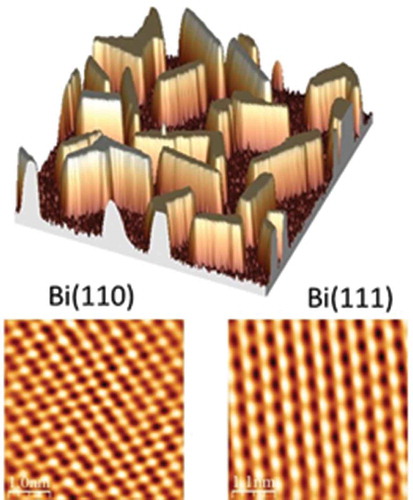Figures & data

Figure 1. Crystalline and electronic structures of bulk Bi. (a) Rhombohedral structure. The basic lattice vectors in rhombohedral and hexagonal indices are indicated by the suffixes (Ro) and (Hex), respectively. In this article, we adopt the rhombohedral index. (b) Brillouin zone and (c) semimetallic band structure of bulk Bi with the rhombohedral structure. Reprinted with permission from (a) [Citation3], (b) [Citation15], and (c) [Citation21]
![Figure 1. Crystalline and electronic structures of bulk Bi. (a) Rhombohedral structure. The basic lattice vectors in rhombohedral and hexagonal indices are indicated by the suffixes (Ro) and (Hex), respectively. In this article, we adopt the rhombohedral index. (b) Brillouin zone and (c) semimetallic band structure of bulk Bi with the rhombohedral structure. Reprinted with permission from (a) [Citation3], (b) [Citation15], and (c) [Citation21]](/cms/asset/18f888af-259b-41f4-9a16-eae7370ad7e3/tapx_a_1845975_f0001_oc.jpg)
Figure 2. (a) Top and (b) side views of the atomic arrangement in Bi(111) films with the bulk-like rhombohedral structure. The Bi atoms in the top bilayer are indicated by light and dark blue closed circles. The unit cell of the atomic arrangement in the Bi(111) plane is indicated by the light blue rhombus. Reprinted with permission from [Citation15]
![Figure 2. (a) Top and (b) side views of the atomic arrangement in Bi(111) films with the bulk-like rhombohedral structure. The Bi atoms in the top bilayer are indicated by light and dark blue closed circles. The unit cell of the atomic arrangement in the Bi(111) plane is indicated by the light blue rhombus. Reprinted with permission from [Citation15]](/cms/asset/762686f5-92f5-477f-a98f-9182fd819a39/tapx_a_1845975_f0002_oc.jpg)
Figure 3. (a) Top and (b) side views of the atomic arrangement in Bi(110) films with the bulk-like rhombohedral structure. (c) Corresponding Brillouin zone. Reprinted with permission from (a) [Citation34] and (b) [Citation15]
![Figure 3. (a) Top and (b) side views of the atomic arrangement in Bi(110) films with the bulk-like rhombohedral structure. (c) Corresponding Brillouin zone. Reprinted with permission from (a) [Citation34] and (b) [Citation15]](/cms/asset/7a0eff80-73a3-43e8-b150-46ef166c0d70/tapx_a_1845975_f0003_oc.jpg)
Figure 4. Relation between the surface buckling and topological band gap. Atomic arrangements of Bi(110) films with the (a) bulk-like rhombohedral structure and (b) BP-like structure. (c) Top and side views of the atomic arrangement at the surface of BP-like Bi(110) films, where denotes the amplitude of the surface buckling. (d) Relation between the surface buckling and the band gap, where the topological transition occurs at
=0.1 Å. Reprinted with permission from (a,b) [Citation37] and (c,d) [Citation30]
![Figure 4. Relation between the surface buckling and topological band gap. Atomic arrangements of Bi(110) films with the (a) bulk-like rhombohedral structure and (b) BP-like structure. (c) Top and side views of the atomic arrangement at the surface of BP-like Bi(110) films, where h denotes the amplitude of the surface buckling. (d) Relation between the surface buckling and the band gap, where the topological transition occurs at h=0.1 Å. Reprinted with permission from (a,b) [Citation37] and (c,d) [Citation30]](/cms/asset/807e7609-94fd-4bbf-9cc3-bde758123a77/tapx_a_1845975_f0004_oc.jpg)
Figure 5. Nucleation and growth of Bi islands on a Si(111)77 substrate at room temperature. (a,c,e) and (b,d,f) show LEED and STM results, respectively. The Bi coverage was 2–4 ML in (a,b), 4–6 ML in (c,d), and greater than 6 ML in (e,f). (g) Theoretically calculated thickness dependence of the cohesive energy of BP-like Bi(110) and bulk-like Bi(111) films. The crystal orientation is indicated using the hexagonal index; the {012} and {001} orientations in the hexagonal index correspond to the (110) and (111) orientations in the rhombohedral index. Reprinted with permission from [Citation37]
![Figure 5. Nucleation and growth of Bi islands on a Si(111)7×7 substrate at room temperature. (a,c,e) and (b,d,f) show LEED and STM results, respectively. The Bi coverage was 2–4 ML in (a,b), 4–6 ML in (c,d), and greater than 6 ML in (e,f). (g) Theoretically calculated thickness dependence of the cohesive energy of BP-like Bi(110) and bulk-like Bi(111) films. The crystal orientation is indicated using the hexagonal index; the {012} and {001} orientations in the hexagonal index correspond to the (110) and (111) orientations in the rhombohedral index. Reprinted with permission from [Citation37]](/cms/asset/71b6f7c4-1809-44db-b8df-d74dd1ce3013/tapx_a_1845975_f0005_oc.jpg)
Figure 6. Nucleation of Bi(110) islands on the Si(111)-B substrate. (a) Typical STM image of the nucleated Bi(110) islands for a Bi coverage of 5.6 MLs. Inset: atomically resolved STM image of the surface of a Bi(110) island. (b) Six preferred in-plane orientations of the nucleated Bi(110) islands. (c) Evolution of the height distribution of the Bi(110) islands. The distributions are magnified tenfold at greater heights for clarity, as indicated by the dashed bars. (d) STM image of a six-ML-thick Bi(110) island with a single-layer terrace. (e) High-resolution STM image of the atomic arrangement in the vicinity of the edge between six- and seven-ML-thick regions. (f) Ball-and-stick model of the atomic structure of the island with six- and seven-ML-thick regions. The six-ML-thick region has the BP-like structure, whereas the seven-ML-thick region has a sandwich structure. Reprinted with permission from [Citation34]
![Figure 6. Nucleation of Bi(110) islands on the Si(111)√3×√3-B substrate. (a) Typical STM image of the nucleated Bi(110) islands for a Bi coverage of 5.6 MLs. Inset: atomically resolved STM image of the surface of a Bi(110) island. (b) Six preferred in-plane orientations of the nucleated Bi(110) islands. (c) Evolution of the height distribution of the Bi(110) islands. The distributions are magnified tenfold at greater heights for clarity, as indicated by the dashed bars. (d) STM image of a six-ML-thick Bi(110) island with a single-layer terrace. (e) High-resolution STM image of the atomic arrangement in the vicinity of the edge between six- and seven-ML-thick regions. (f) Ball-and-stick model of the atomic structure of the island with six- and seven-ML-thick regions. The six-ML-thick region has the BP-like structure, whereas the seven-ML-thick region has a sandwich structure. Reprinted with permission from [Citation34]](/cms/asset/9c032245-3ae1-4e58-a811-050e78321a81/tapx_a_1845975_f0006_oc.jpg)
